Let yourself be carried away on a unique journey along the Mile of Beauty, an original itinerary created to best celebrate the Capital of Culture Bergamo Brescia 2023. Step by step you will encounter all of Bergamo’s beautiful traits and get to know it from a different perspective.
Let yourself be guided through an unusual journey among noble residences, works of art, alleys, stairways and much more without forgetting, of course, one of the most beautiful squares in Italy. Full of curiosities, venture into a city that is waiting for you to reveal its best secrets and to leave you speechless.
Our advice is to start from the Cittadella Viscontea in the Upper Town down to the foot of the Venetian Walls, but there is no fixed rule: your Mile of Beauty also works the other way around!
Let yourself be carried away on a unique journey along the Mile of Beauty, an original itinerary created to best celebrate the Capital of Culture Bergamo Brescia 2023. Step by step you will encounter all of Bergamo’s beautiful traits and get to know it from a different perspective.
Let yourself be guided through an unusual journey among noble residences, works of art, alleys, stairways and much more without forgetting, of course, one of the most beautiful squares in Italy. Full of curiosities, venture into a city that is waiting for you to reveal its best secrets and to leave you speechless.
Our advice is to start from the Cittadella Viscontea in the Upper Town down to the foot of the Venetian Walls, but there is no fixed rule: your Mile of Beauty also works the other way around!
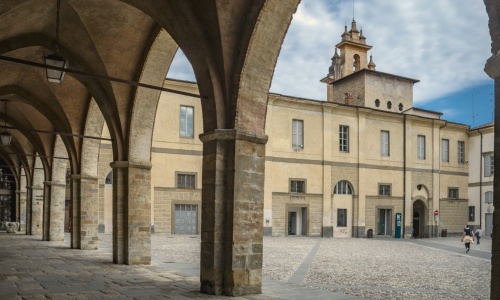
The first stop of the Mile begins in Piazza della Cittadella: one of the Upper Town’s characteristic squares, whose multifaceted past has left signs that are still clearly visible. Can you spot them? A few metres away from each other you can find a stretch of Roman road, a postern of the ancient medieval walls and Romanesque pillars, just to name a few.
All of Bergamo's historical-scientific knowledge is also preserved here. You cannot miss the interactive visit to the "E. Caffi" Museum of Natural Sciences, which preserves minerals, fossils, animals and insects, and the one at the Civic Archaeological Museum, which from a simple and initial "collection of antiques" has today come to guard a collection of inestimable value.
The first stop of the Mile begins in Piazza della Cittadella: one of the Upper Town’s characteristic squares, whose multifaceted past has left signs that are still clearly visible. Can you spot them? A few metres away from each other you can find a stretch of Roman road, a postern of the ancient medieval walls and Romanesque pillars, just to name a few.
All of Bergamo's historical-scientific knowledge is also preserved here. You cannot miss the interactive visit to the "E. Caffi" Museum of Natural Sciences, which preserves minerals, fossils, animals and insects, and the one at the Civic Archaeological Museum, which from a simple and initial "collection of antiques" has today come to guard a collection of inestimable value.
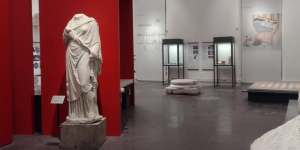
The first exhibition of the current Archaeology Museum was located in the Loggia under the Palazzo della Ragione, in Piazza Vecchia, where it was simply a “collection of old stuff” and included several epigraphs.
Since then, the collection moved several times: in fact, it required more and more space due to the conspicuous and constant donations over the centuries. Today the Museum is housed in the Cittadella Palace (XIV Century) built by the Visconti family, Milan’s ancient rulers, in a new, expanded exhibition created in occasion of Bergamo brescia Capital of Culture 2023.
Visitors can plunge into history just looking at the museum’s walls. Visiting the Archaeology Museum is like going on a journey across the history of Bergamo and its territory, from its prehistoric background to the Langobardic domination in the Middle Age.
It is very common do find groups of children and kids inside it. In fact, the “Centro Didattico-culturale”, the former “Gruppo Guide del Museo” established in 1981, contributes to give a strong educational spirit to the Museum, by carrying out many guided tours, workshops and activities for children and adults.
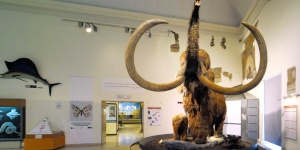
Located next to the Archaeology Museum in Piazza della Cittadella, where it was moved in the same year (1960), the Museum of Natural Science keeps most of its collections in its archives, in order to let scientists study them and develop the knowledge about environment, living animals and extinct species. It was established in 1861 in the building of Regio Istituto Tecnico: today, it hosts millions of natural findings!
Before entering the Museum, we have a little warning for you: an enormous mammoth is going to welcome you at the entrance. But don’t be afraid, it is extremely friendly!
Right after the Museum’s prehistoric guardian you will find many specimens, divided into groups: zoology, entomology, geology and palaeontology. Afterwards, you can admire many examples of all five classes of vertebrates, along with a wide and rich collection of arthropods, with more then one million specimens!
You can also admire the shimmering collection of minerals. Moreover, if you loved Jurassic Park you will also love the amazing fossils coming from Bergamo territory and from all over the world: over 55.000 findings, including a fantastic life-size cast of the skeleton of an Allosaurus, a large bipedal dinosaur!
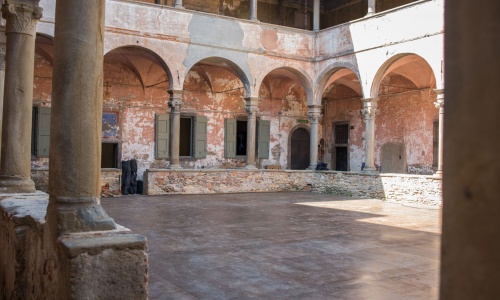
Take the portico located at the base of the Bell Tower, reach Piazza Mascheroni (once called Piazza Nuova) and continue along Via Colleoni, better known as Corsarola.
Almost hidden from the comings and goings of locals, tourists and students as well as from the narrow shape of the street, entrances to the Upper Town’s main centres of cultural activity magically open up: the Teatro Sociale and the Former Carmine Monastery, still today in full swing with a rich program of shows and events not to be missed.
Take the portico located at the base of the Bell Tower, reach Piazza Mascheroni (once called Piazza Nuova) and continue along Via Colleoni, better known as Corsarola.
Almost hidden from the comings and goings of locals, tourists and students as well as from the narrow shape of the street, entrances to the Upper Town’s main centres of cultural activity magically open up: the Teatro Sociale and the Former Carmine Monastery, still today in full swing with a rich program of shows and events not to be missed.
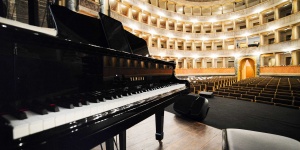
There is no porch or colonnade at the entrance of the Teatro Sociale, because the street is too narrow: nevertheless, this place is extremely surprising. Once you stepped in, you enter a magical, cosy and refined setting, warmed by the wooden balustrades and the beams of the ceiling.
The boxes’ vertical layout features three orders plus a fourth gallery, visually representing the old hierarchical groups.
The architect Leonardo Pollack was asked to design this kind of structure by the aristocratic sponsors of the theatre, as to underline the class differences of that time. In fact, the “Teatro della Società” (“Theatre of Society”), as it was originally called, was born to face a challenge: containing the constant and relentless loss of prestige of Città Alta – the Upper Town – in the favour of the Lower Bergamo’s districts.
Despite its splendour, the theatre presence wasn’t enough to reverse the course of history.
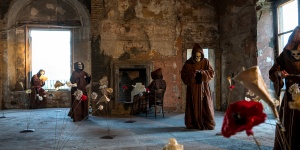
Designed in the first half of the fourteenth century by the Carmelites, it was built between the end of the fifteenth and the beginning of the sixteenth century. In the seventeenth century the stables, the chapter house and a new library were built.
The heart of this majestic structure is the rectangular cloister, with a portico of round arches. The arches are supported by columns with composite type capitals surmounted by pulvini and placed on a low wall. On the first floor, there are architrave loggias.
In the eighteenth century, the monastery entered a period of decline and abandonment and the rooms and cloister were prepared to become apartments for rent. In 1954 it was declared unusable and static consolidation work of the structure began. In recent years, thanks to important restoration work, the monastery has returned to show all its beauty and has rediscovered its place in the fabric of the city.
Today, in fact, it is managed by TTB - Tascabile Theatre of Bergamo, a historic international theatre company, which obtained it under concession from the Municipality of Bergamo. They made it their headquarters, taking care of the place and making it possible to use it for cultural events, shows and concerts.
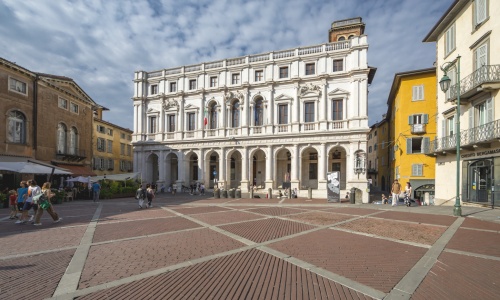
Continue straight until one of the most beautiful places in Italy opens up in front of you: Piazza Vecchia. It's time to discover the heart of Upper Bergamo!
Its grandiose monuments will leave you with your eyes to the sky - but don't forget to take a look at where you put your feet, because under the Palazzo della Ragione you will find a rare, ancient camera obscura sundial, guiding you towards Piazza Duomo. Near the Baptistery, however, you will be able to realise the dimensions of what is said to be the largest bell in Lombardy, that of the Civic Tower, known as the "Campanone".
Continue straight until one of the most beautiful places in Italy opens up in front of you: Piazza Vecchia. It's time to discover the heart of Upper Bergamo!
Its grandiose monuments will leave you with your eyes to the sky - but don't forget to take a look at where you put your feet, because under the Palazzo della Ragione you will find a rare, ancient camera obscura sundial, guiding you towards Piazza Duomo. Near the Baptistery, however, you will be able to realise the dimensions of what is said to be the largest bell in Lombardy, that of the Civic Tower, known as the "Campanone".
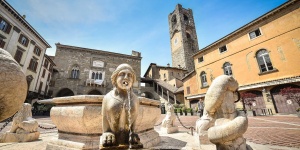
Piazza Vecchia represents the core of Città Alta: it has been the heart of political power for centuries and it keeps being one of the most popular places for Bergamo’s citizens to spend some time with friends.
Beauty is all around you if you have a seat at one of the square’s restaurants or cafes, having a drink, breakfast or even a romantic dinner. You can admire the building called “Palazzo della Ragione”, the oldest municipal seat in Lombardy, as well as the Torre Civica, a bell tower also called “Campanone”.
In the middle of the square is located the Contarini Fountain, which was donated to the city by the chief magistrate Alvise Contarini in 1780, while on the opposite side of Piazza Vecchia you can see the Palazzo Nuovo (“New Palace”), which served as Bergamo’s Town Hall until 1873 and is today the seat of the Angelo Mai Library. Its incredible collection includes ancient and precious books: incunabula, books from the 1500s, engravings, manuscripts and other inestimable artefacts making it one of the most outstanding libraries in Italy.
The geometrical layout of the buildings around the square is so harmonic that when Le Corbusier visited Bergamo he said “you can’t move a single stone, it would be a crime”
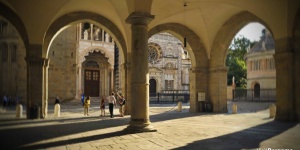
Going under the ancient Administration Headquarter you can enjoy the best of medieval architecture: buildings full of history and beauty perfectly combine practical functionality and elegance.
Over its long existence, the Palace has been damaged and rebuilt several times: it was also used for many different purposes, also becoming a theatre and a library!
Today, after 800 years, with its beautiful architecture style the Palace represents all the art and the history of Bergamo, also hosting numerous art exhibitions.
The Palazzo della Ragione is a must-see in your itinerary across our city!
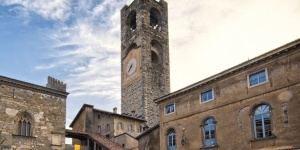
In the heart of Piazza Vecchia stands the Civic Tower, otherwise known as the Campanone, which with its height of 52.76 metres, offers a breathtaking panoramic view of the old town.
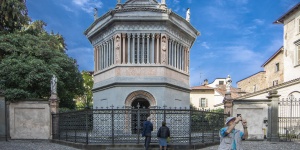
The “eight” represents a sort of magical number in this building.
Eight walls, geometrically shaping its profile and making it so particular. Eight are the bass relieves decorating the interior walls with the scenes from the Life of Jesus, realized by the renowned XIV Century sculptor Giovanni da Campione. Also eight statures stand on the dome, outside, representing the Virtues: Faith, Hope, Charity, Fortitude, Justice, Prudence, Temperance, plus Patience.
Here’s a tip: if you want to play a short game, try to match each statue with its corresponding Virtue and ask your friends to do the same!
The Archangel on top of the dome will be your judge.
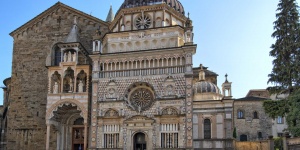
It’s surely the most beautiful building in Bergamo.
Its façade is decorated with red and white marble, an authentic Italian Renaissance masterpiece. The interiors are a fantastic collection of artworks: the equestrian statue of Bartolomeo Colleoni, mercenary captain from Bergamo, the marble sarcophaguses, the exquisite tomb of his daughter Medea, the inlayed wooden desks.
It would takes us pages and pages to describe them all, that’s why we suggest you to enter the chapel and let this art universe take you over!
Fun fact: legend has it that touching the coat of arms on the Chapel’s gate at midnight brings good luck. Believe it or not, it can be a nice excuse to take a walk to the lovely Città Alta by night!
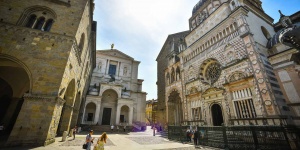
There’s a deep and old connection between the city and Santa Maria Maggiore Basilica, maybe due to the peculiar circumstances of its construction. During the first years of 1100, a terrible plague breakout spread across Europe, causing death and desolation. That’s why the people of Bergamo decided to ask the Virgin Mary to assist them: they vowed to dedicate a church to Her if she had protected them from being infected. Being men of their word, in 1137 Bergamo’s citizens started to built the Santa Maria Maggiore Basilica on the Piazza del Duomo, in the Upper Town. They actually acted big: the church turned out to be really beautiful, and it was adorned even more in the following centuries. Frescoes, stuccos, tapestries and wooden marquetry designed by the renowned artist Lorenzo Lotto decorate the inside of the building.
Santa Maria Maggiore also houses the funerary monument dedicated to Gaetano Donizetti, the famous music composer, symbol and representative of Bergamo all over the world.
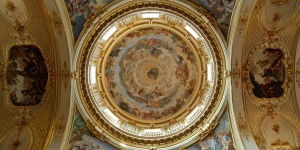
The Cathedral, or “Duomo”, is located in Piazza Duomo, in the heart of the Old Town: this area was already a sacred place in the V Century B.C., as proved by the underground layers. The building holds numerous treasures, such as the paintings by Giovan Battista Moroni and Andrea Previtali, the Martyrdom of Saint John Bishop by Giambattista Tiepolo, an altarpiece by Carlo Ceresa and some wood and marble inlays by Andrea Fantoni.
However, the most precious item you can admire is the tiara belonged to Pope John XXIII, now Saint John XXIII, who was born in the village of Sotto il Monte, near Bergamo: a sparkling gold headgear decorated with pearls, rubies, diamonds and emeralds, created by the goldsmith Attilio Nani.
The mortal remains of Saint Alessandro Martyr, Bergamo’s patron saint, are kept in an urn inside the high altar.
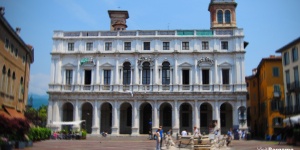
Palazzo Nuovo (“New Palace”) is like a theatre wing located in via Colleoni, overlooking the Piazza Vecchia. It’s called like that in contrast with Palazzo Vecchio (“Old Palace”) aka Palazzo della Ragione, standing in the opposite side of the square.
It took three centuries to build it: the works started in 1604 and ended in 1928. The Palace has served as Bergamo’s Town Hall for three hundred years, till 1873.
Since 1928, one of its rooms has been hosting one of Italy’s most renowned libraries, the “Civica Angelo Mai”, safeguarding parchments, incunabula, codices and precious music sheets.
Inside the Tassiana Hall, you can admire the wonderful globes by Vincenzo Maria Coronelli, cosmographer of the Venice Republic. Dating back to 1688 and 1692, they feature a 3 m circumference and are made of 50 illustrated sheets. Take a look at them: are they really different from today’s ones?
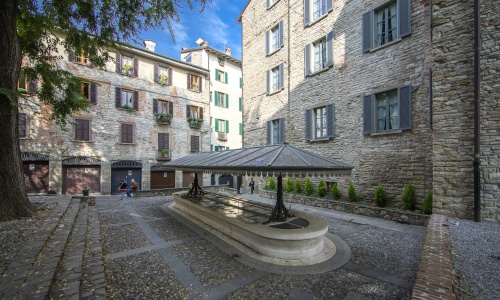
After having filled up on Beauty, locate the Via Ca' Longa portico near Palazzo della Ragione, right next to the restaurant that was already a tavern in the 15th century: this little shortcut takes you straight to one of the most loved views of Upper Bergamo.
At the end, you will find a charming tree-lined square where the Old Washhouse and the tallest tower in the city, the medieval Gombito Tower, reign supreme. From here you can take a small detour if you like: turn right, go up Via Mario Lupo and you will soon be rewarded with one of the most iconic views ever, that of the elegant Palazzo Terzi, whose entrance opens onto the famous terrace with the statues overlooking the lower town.
Then retracing your steps, cross the square with the Old Washhouse and take the last shortcut on the right, between the flowerbeds and the stairways of Piazzetta Angelini, until you reach Piazza Mercato delle Scarpe. Located at the meeting point of the town’s main access roads, it was the place formerly dedicated to trade; still today it is an important crossroads, full of charm and secrets to be discovered.
After having filled up on Beauty, locate the Via Ca' Longa portico near Palazzo della Ragione, right next to the restaurant that was already a tavern in the 15th century: this little shortcut takes you straight to one of the most loved views of Upper Bergamo.
At the end, you will find a charming tree-lined square where the Old Washhouse and the tallest tower in the city, the medieval Gombito Tower, reign supreme. From here you can take a small detour if you like: turn right, go up Via Mario Lupo and you will soon be rewarded with one of the most iconic views ever, that of the elegant Palazzo Terzi, whose entrance opens onto the famous terrace with the statues overlooking the lower town.
Then retracing your steps, cross the square with the Old Washhouse and take the last shortcut on the right, between the flowerbeds and the stairways of Piazzetta Angelini, until you reach Piazza Mercato delle Scarpe. Located at the meeting point of the town’s main access roads, it was the place formerly dedicated to trade; still today it is an important crossroads, full of charm and secrets to be discovered.
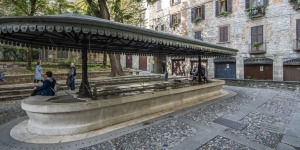
A long tank of white marble divided into different parts, covered by an elegant roof made of cast iron and metal slabs.
Built in 1881, the Washhouse (“Lavatoio” in Italian) via San Lupo, in the Upper Town, represents a beautiful model from the design point of view.
It’s provided with a water adduction system, an overflow drain system, a process of dirty water discharge after washing and a gutter of the water sprays produced during the washing: this makes it extremely effective and functional.
On the other side, the hygienic conditions of Bergamo during that time were really poor: in 1884 a cholera epidemic had pummelled the city and physicians blamed the water’s terrible quality of Città Alta, enhancing the spreading of typhus fever, a highly contagious and frequently deadly disease that recurred every summer.
To combat this problem, Bergamo Administration decided to build several public washhouses: besides the one in via Lupo, there was one in via Boccola and another in Borgo Canale.
The via Lupo Washhouse worked till the 50s and it’s currently preserved with the maximum care, as a precious memory of the past.
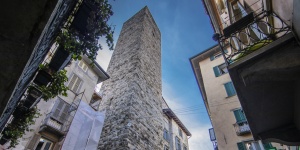
That’s an odd name, indeed! Do you know its origin? “Gombito” is the Italian evolution of the Latin word “compitum”.
However, there are several interpretations about the meaning of “compitum”. Some say it means “crossroad”, as the tower rises in the meeting point between the two main axis of the Roman town, the “decumanus” and the “cardo” (today’s via Gombito and via Lupo). Another argument claims that “compitum” means computare”, “counting”: in fact, the old numbering system of the streets started from here.
The imposing Gombito Tower was built in 1200 as a symbol of power and military hegemony during the struggles between the different city factions: it used to control the access to Piazza Vecchia, the core of Bergamo, from the roads coming from the valleys. Bergamo Administration owns it and opens it to the public in spring and summer: from its top you can enjoy a fantastic view of the surrounding territory!

Two marriages led to the two building phases of Palazzo Terzi: the wedding of the Marquise Luigi Terzi with the young Paola Roncalli in 1631 and the one between the Marquise Gerolamo Terzi and Giulia Alessandri more one hundred years later.
During the first stage, the façade and the southern wing were built, while during the second one the opposite square was enlarged. As you arrive in front of the entrance, the wonderful terraced garden organized on different levels will surely impress you: in fact, the view from here is incredible.
The interiors are no exception: the Mirrors Sitting Room, the Red Hall, the Hall of Honour are fantastic examples of the XVIII Century “Barocchetto” style. Moreover, in the middle of the ceiling of the Sala del Tiepolo, you can also admire a beautiful artwork ascribed to Giovanni Battista Tiepolo.
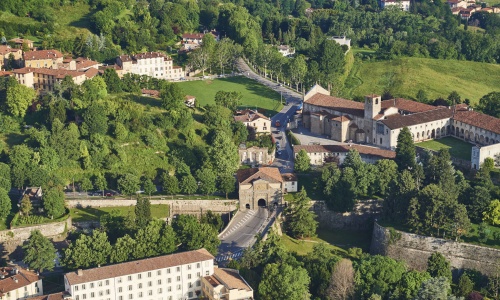
The descent begins! Take Via Porta Dipinta on the left and let yourself be captivated by its hidden treasures: from Palazzo Moroni and its Gardens, heritage of the FAI, to the apparently simple church of Sant'Andrea, up to the art history lesson with works by Lotto in the church of San Michele al Pozzo Bianco.
At the end, you will already be able to see the former complex of Sant'Agostino, which gives its name to the monumental access gate to the town and is now the seat of the University of Bergamo. Walk along it, pass through Porta Sant'Agostino, go down for a while keeping to the left and, when you arrive at the beginning of Via Pignolo, immediately take Via della Noca on your left; leaving behind the monumental gate, with its distinctive Venetian lion, to venture onto the route of one of the city’s typical medieval stairways.
The descent begins! Take Via Porta Dipinta on the left and let yourself be captivated by its hidden treasures: from Palazzo Moroni and its Gardens, heritage of the FAI, to the apparently simple church of Sant'Andrea, up to the art history lesson with works by Lotto in the church of San Michele al Pozzo Bianco.
At the end, you will already be able to see the former complex of Sant'Agostino, which gives its name to the monumental access gate to the town and is now the seat of the University of Bergamo. Walk along it, pass through Porta Sant'Agostino, go down for a while keeping to the left and, when you arrive at the beginning of Via Pignolo, immediately take Via della Noca on your left; leaving behind the monumental gate, with its distinctive Venetian lion, to venture onto the route of one of the city’s typical medieval stairways.
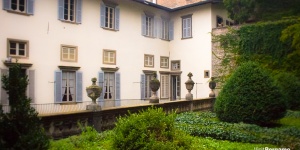
Palazzo Moroni is located in Via Porta Dipinta (Upper Town) and is characterised by exceptionally well-preserved interiors and furnishings, as well as a rich art collection and an Italian garden with a large vegetable garden. The magnificent building therefore offers visitors not only art and history, but also an enchanting historical park in the heart of Upper Bergamo.
The Moroni family has owned and lived in the building since 1636. The original layout has been carefully maintained and preserved; the monumental staircase leads from the entrance courtyard to the noble floor, behind whose doors are rooms and halls frescoed and furnished between the seventeenth and nineteenth centuries.
In the main rooms the proofs of Barbelli's fresco mastery remain in all their beauty, and here is also preserved the large and varied Moroni Collection. Here, in addition to works by Bernardino Luini, Cesare Tallone, the famous portraits of Gian Gerolamo Grumelli (The Knight in Pink) and Isotta Brembati stand out, executed by the painter Giovanni Battista Moroni of Albino.
Since its construction, the building overlooks a complex of Italian gardens, divided into a balcony and three terraces that develop close to the Sant’Eufemia Hill. The third and highest terrace gives access to the Count's Thinking Room, a neo-medieval style tower built in the nineteenth century on the remains of an older structure, formerly belonging to the civic fortress, which surrounds the top of the hill.
Beyond the actual gardens there are about two hectares of vegetable garden, annexed to the property during the nineteenth century thanks to the brothers Pietro and Alessandro Moroni, the latter scholar of agronomy. In the area, there are still vines grown on pergola, fruit trees and a roccolo, that is a circle of hornbeam trees, whose intertwined branches acted as nets to hunt live birds for food and play. There are also mulberry trees, one of the symbols of the family, enriched with the breeding of the silkworm that feeds on the leaves of this tree.
Thanks to the agreement between the FAI - Italian Environment Fund and the Palazzo Moroni Museum Foundationin December 2019, aimed at the restoration, management and enhancement of the superb Bergamo property, Palazzo and Giardini Moroni are now regularly open to the public.
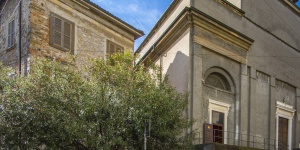
Walking along Via Porta Dipinta in the Upper Town, you will notice an imposing structure with a simple facade: this is the Church of S. Andrea Apostolo.
The church was built starting in 1837 on the remains of a cemetery basilica, through a radical intervention designed by architect F. Crivelli, which envisaged a structure in full neoclassical style. Of the façade, however, only the three portals were completed, architraved with a linear and slightly molded cornice, with two scroll brackets supporting the cornice above the architrave.
The interior of the building has three naves, separated by half-columns with Corinthian-style capitals. The dome, which can be seen from the nave, was painted with a trompe-l'oeil coffered effect.
St. Andrew the Apostle is famous for the remarkable paintings preserved inside, which belonged to the earlier church. Among the names of the artists who decorated it are Salmeggia ("Natività adorata dai pastori"), Bassano (Pala di San Donnino), Padovanino (Trittico di Sant'Andrea), Moretto da Brescia ( "Madonna in trono col Bambino tra i santi Eusebia, Andrea, Domnione e Domnone") and Jacopo Palma il Giovane ("Natività adorata dai pastori") to name but a few.
The church also features a Museo Storico e di Arte Sacra (Museum of History and Sacred Art) (as of 2021), as well as the premises of the Centro Universitario S. Andrea University Center with the "James A. Podboy" library.
The underground rooms of its crypt are also home to the Teatro S. Andrea, an early version of which was built in 1951 as a kineteater complete with stage, wings, curtain plus a film projection booth. Since 2018 it has been managed and progressively restored by the Centro Universitario Teatrale di Bergamo, which has made it the home of the acting school and student association CUT Bergamo, as well as prestigious shows and musical performances.
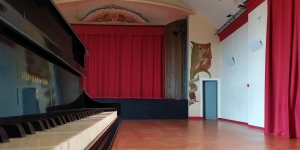
Located in one of the most characteristic streets of Upper Bergamo, the S. Andrea Theatre has a particular history, full of surprises, faith and culture.
It is located in the crypt of the homonymous church, built between 1840 and 1847 on the basis of a building from the eighth century AD. During the works, the floor was raised above the road and, at the same time, an excavation on the side of the hill made it possible to gain further depth. Thanks to this it was possible to obtain the underground environment under the church. The space was intended for about a century to preserve works from other places of worship, as well as from the pre-existing one.
A first version of the S. Andrea Theatre was created by the will of the parish priest Antonio Galizzi who, in 1951, had a cinema theatre in the crypt, complete with stage, wings and curtains plus a booth for cinema projections. Over time, however, the cine-theatrical activity ceased and the space was destined for other uses, mainly an oratory and a sports space, until its closure in the 1990s.
Only in 2018, thanks to a lucky meeting, the University Theatre Centre of Bergamo accepted the difficult challenge and takes charge of the restoration and management of the hall. Thanks to the personal commitment of the teachers and CUT members but also to the parish priest of Sant'Andrea himself and to some sponsors, the underground environment of the church has finally returned to being a theatre in all respects.
The room can accommodate up to 100 people and has a unique layout: the stalls correspond to the apse and presbytery of the church above, while the curtain and stage develop under the nave.
On the sides of the curtain there are decorations depicting the masks of Harlequin and Pulcinella, made by Albano Pressato in the 1950s. From 2020 another exceptional piece has been added to the furnishings: the 1932 Steinway grand piano, formerly owned by Giorgio Zaccarelli and donated to the theatre by his children, located in the apse.
Since the reopening, the theatre is home to the CUT acting school and student association of Bergamo, as well as prestigious musical performances and exhibitions such as the 4Hands Piano Festival, seasonal events organised by the Donizetti Foundation and, from 2022, also the Bergamo Jazz Festival.
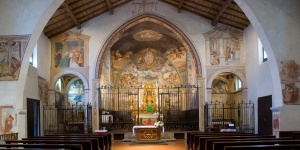
Did you know that the famous Renaissance artist Lorenzo Lotto lived in the House of the Vicar, next to this church? Today the house partially belongs to the Ursuline sisters pension; also due to this favourable position, the Venetian Master created some wonderful artworks in the San Michele al Pozzo bianco Church, including the cycle of frescoes depicting the Episodes of Mary’s Life, painted in 1525 in the left side chapel.
If you love art, this church is a real treasure chest: in fact, it hosts some of the most ancient frescoes in Bergamo’s territory and represents an outstanding “lesson” of the local painting history, ranging from the early XIII Century to the late XVI.
The round stone you can now see on the churchyard marks the place where the ancient white well used to be, giving the name to the church itself.
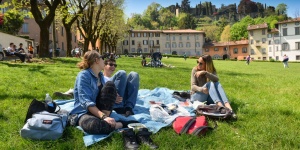
The Fara rampart and meadow are located next to the St. Agostino rampart, near the St. Agostino Gate, at the eastern end of the Upper Town walls. The rampart is part of the fortifications built in the XVI century by the Venetian Republic to protect Bergamo, today a UNESCO site, and together with the Fara curtain wall it defended the area between the St. Agostino and St Lorenzo ramparts.
Today it is a panoramic and much-loved part of the strolls along the walls, thanks to the tranquillity of the area and the presence of many places where people can relax.
More internally, just in front of the former St. Agostino Church, there stretches the Fara meadow, once and for a long time an inaccessible area. Here in fact was what the Bergamo people called "fupù", a big pit in the ground then filled, during the 1930s, with the debris from abandoned and irrecoverable Upper Town buildings, demolished as part of the consolidation project started by engineer Luigi Angelini.
Today, luckily, this meadow is a meeting place for many people: as soon as the warm season comes, the area is full of sportsmen, groups of friends and families wishing to spend time outdoors. What are you waiting for? Come join them!
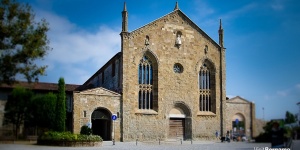
The former monastery and the ex Church never changed their original purpose: they have been devoted to culture forever.
In fact, this monastic complex established in 1290 by the Eremitani Friars, which then passed to the Observant Friars in 1407 (both belonging to the Saint Augustine Order), soon became the seat of an important centre for religious and cultural research.
In 1647, it began to host the Accademia degli Eccitati, while in 1670 schools of philosophy and theology opened. Today, tradition goes on: the monastery currently houses a branch of Bergamo University, while the ex Church has ben recently restored and it is used as Lecture Hall.
The refurbishment restored the old glory of this ancient gem of Città Alta: from the outside, you can admire the gabled gothic façade in sandstone, along with the Nordic-style round arch entrance portal. Once you stepped inside, you will be amazed by the majestic wood coffered ceiling and by the medieval frescoed walls, enlightened by the wide windows.
Right in front of the ex Church of Sant’Agostino there is the Fara Lawn. When spring comes, this place gets full of people practicing sport, relaxing with friends and enjoying some fresh air. Would you like to join them?
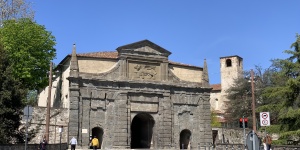
Porta Sant’Agostino has been the main entrance to the Upper Town – Città Alta – for a very long time, both for the inhabitants of Bergamo who went up from Borgo Pignolo and for those who came from Venice. Even today, this passage represents the most commonly used way to move from the Upper Town to the Lower Town and backwards, walking or using public and private transportation.
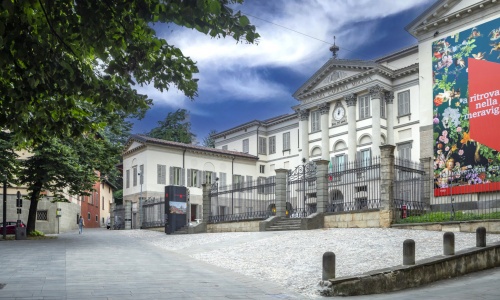
The last stop on your Mile of Beauty. Don't be intimidated by the "non latius" ("no further") engraved on the small stele at the base of the Noca and reach Piazza Giacomo Carrara. You are among the big names in Bergamo's artistic expression: innovation, creativity, collections and unique perspectives are just some of the elements that the Accademia Carrara and the Modern Art Gallery have to offer you. Discover the unmissable permanent collections and let yourself be fascinated by the temporary exhibitions that these two museums always have in store for you!
Too good for just one ride? You can also make Piazza Carrara your starting point and walk the Mile upwards, discovering the Beauty of the city from the foot of its walls to the top of its hills.
The last stop on your Mile of Beauty. Don't be intimidated by the "non latius" ("no further") engraved on the small stele at the base of the Noca and reach Piazza Giacomo Carrara. You are among the big names in Bergamo's artistic expression: innovation, creativity, collections and unique perspectives are just some of the elements that the Accademia Carrara and the Modern Art Gallery have to offer you. Discover the unmissable permanent collections and let yourself be fascinated by the temporary exhibitions that these two museums always have in store for you!
Too good for just one ride? You can also make Piazza Carrara your starting point and walk the Mile upwards, discovering the Beauty of the city from the foot of its walls to the top of its hills.
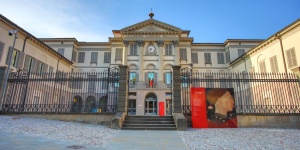
Museum
The Accademia Carrara in Bergamo is a museum with a specific and, in some ways, unique identity, closely tied to its origins and history. Unlike many Italian museums, Carrara is the result of the ambitious project of Giacomo Carrara (1714-1796) to promote the establishment of a cultural institution that would combine pleasure and education, serving as both an art gallery and a painting school. The success of this idea is evidenced by the extensive series of large and small donations made over more than two centuries by individuals and institutions. These, along with a few targeted acquisitions, have complemented the original foundation laid by the founder. Besides Carrara, leading the long list of donors are notable figures such as Guglielmo Lochis, Giovanni Morelli, Federico Zeri, and Mario Scaglia. Their collections form the backbone of the museum and contribute to defining the diverse and articulated character of its heritage.
The renewed visitor's journey is organized in 16 differently-sized rooms, showcasing a total of 350 exhibited works, including paintings, sculptures, medals, and plaques. Visitors thus have the opportunity to embark on a five-century journey through the history of Italian art, from the Renaissance to the nineteenth century, encountering masterpieces by Pisanello, Mantegna, Botticelli, Raphael, Titian, Lotto, Moroni, Hayez, and Pellizza da Volpedo.
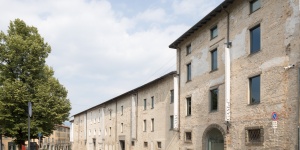
The Gallery of Modern and Contemporary Art was founded in 1991 right in front of the Accademia Carrara Picture Gallery, in a restored fifteenth-century architectural complex, formerly intended as a monastery. The diversified programming - open to experimentation with contemporary languages and to multidisciplinarity, and at the same time anchored to the roots of the institution and its heritage - has made it into a multifaceted space that has been able to involve different audiences over the years. With its 1500 square metres of exhibition space, it is a place that welcomes contemporary art in all its forms: temporary personal and collective exhibitions by international artists, new and emerging projects and a rich calendar of collateral activities designed for different audiences are the strong point of the Gallery’s cultural policy, which is a dynamic place for comparison, analysis and cultural integration, in constant evolution.